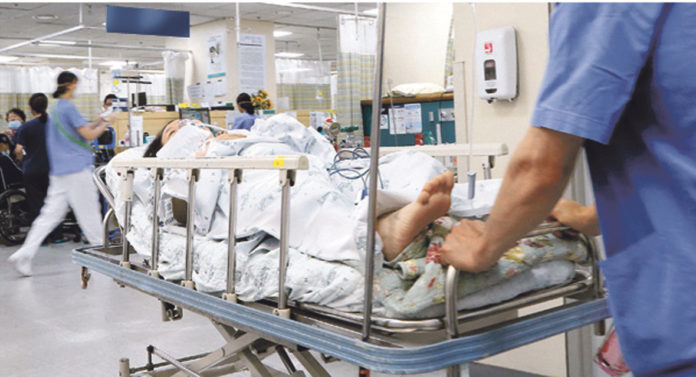
by David Raleigh
THERE was just one intensive care bed available in the Mid West today as public health experts warned a surge in breakthrough Covid-19 infections would likely result in an increased number of hospitalisations or death due to a surge in the virus in the region.
The Department of Public Health Mid West advised people in Limerick, Clare and North Tipperary to “limit” their social activity as Covid-19 infection rates doubled in the region over the past four to five weeks.
A spokesperson for the agency warned that, “due to the sharp escalation in new cases in recent weeks, breakthrough infections with serious outcomes are more likely to occur amid current widespread community transmission”.
Serious outcomes, he said, include “getting seriously ill or dying”.
“People’s conditions can deteriorate quite rapidly, from them being quite well to their lung capacity shrinking almost and then they require intensive treatment immediately – that’s the nature of Covid, and because of the sheer volume of cases, we will, more than likely see more cases of people getting sick.”
This, he said, was despite recent trends of “a lower incidence of serious illness and death, largely thanks to the successful Covid-19 vaccination programme”.
The spokesperson also warned of “significant pressure” on surveillance and contact tracing teams due to the surge in daily case numbers, which was hampering its ability to “visualise a full picture of the spread of the infection in the region”.
Over the past two weeks there have been an average of 128 cases recorded daily in Limerick alone. For the same period 3,374 cases were identified in the region, including 1,801 in Limerick, 1,027 in Clare, and 546 in North Tipperary.
The average age of those infected (79 per cent) is 18; 13 per cent are aged 5-11; 5 per cent are aged 12-17; and 3 per cent are aged 0-4, according to Public Health Mid West.
Public Health Mid West said it was continuing to managing outbreaks of Covid-19 in nursing homes, long term residential care facilities, health care settings, workplaces, schools, and other community settings.
Dr Mai Mannix, Director of Public Health Mid West, warned that despite over 90 per cent of the region having received at least one Covid-19 vaccine dose, due to a recent surge in cases, “we will likely see a greater number of people with Covid-19 in hospital this winter period”.
She said this situation could be “reversed” through limiting social activity and contacts.
Dr Mannix urged people with Covid symptoms and who are relying on antigen tests with ‘not detected’ results to “self isolate and book a free PCR test to accurately determine their Covid-19 status”.
Urging people to “limit their social activity and social contacts over the coming weeks”, Dr Mannix also noted that her team “are seeing a trend of some workplaces dropping their guard in terms of mask-wearing, which is high-risk when Covid-19 is circulating widely in the community”.
Meanwhile, a spokesperson for University Hospital Limerick, (UHL), said that “Covid-19 activity in University Hospital Limerick remains high, with 37 Covid-positive inpatients being treated in the hospital, of whom eight are receiving critical care, either in the Intensive Care or High Dependency Units”.
Management “continue to manage a Covid outbreak in the hospital that has affected five inpatient wards and resulted in a hospital-wide visiting ban”, they said.
There were 71 staff absent across the UL Hospitals Group, this Wednesday, including “a small number of Covid-positive cases, staff who are symptomatic and staying home in line with public health guidance, and those awaiting results of Covid-19 swab tests,” a spokesperson said.
“In addition today, there are 27 staff across the Group who are vulnerable to Covid-19 and, for their own safety, must remain off-site for now.”
An “escalation plan, including undertaking additional ward rounds, accelerating patient discharges, and identifying patients for transfer to Model 2 hospitals in the region”, is being implemented, due to exceptionally high presentations at the hospital’s emergency department (ED).
Today, 77 patients languished on trolleys in the hospital, including 56 in the ED and 21 on wards.
The hospital’s spokesperson said, despite the escalation plan to reduce pressure on the hospital system, it remained somewhat hamstrung as “current demand for our services is multi-faceted and high numbers of admitted patients require a level of care that, for the Mid-West, can only be provided at UHL”.
“In general, patients currently admitted to UHL are sicker and with more complicated conditions, and require longer inpatient stays to recover,” they said.
In pre-Covid 2019, the average daily patient attendance at the Limerick ED averaged 195, however last month the daily average attendance at the ED was 226 – this jumped to 242 in the 24 hours to 8am this Wednesday.
The spokesperson urged the public “to consider all available care options before presenting to the ED” including local injury units operating seven days a week in the region, but he added that, “if you are seriously injured or ill or are worried your life is at risk the ED will assess and treat you as a priority”.
Patient overcrowding as well as lengthy delays in accessing a bed at UHL continues.
“We apologise to any patient who has experienced a long wait for admission to UHL during this period of exceptionally high demand for our services,” the spokesperson said.
UHL has added ten critical care beds since the start of the Covid-19 pandemic, bringing the hospital’s total compliment of these beds to 28, including 12 Intensive Care beds and 16 High Dependency beds.
Despite the additional capacity, latest figures published by the HSE showed there was only one ICU/HDU bed available at the hospital, which caters for the entire region’s catchment of over 400,000.
Advertisement








